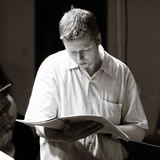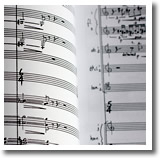SKIN: multi-media dance work
Recorded at The Cube, Project Arts Centre, Dublin/IR, 2005.
Ian Wilson, music; Jenny Roche, dance; Ian Joyce, visuals.
Collaborations between artists of diverse disciplines are often judged on their ability to coalesce. We determine the success of common ground found in pre-production artistic dialogue by what we can spot on opening night: a dancer’s sweeping arm in time with a similar musical gesture, or dark visual images reflected in comparable musical tonal colours. But common ground is often a barren place.
Shared strengths can also be shared weaknesses and the richness in collaboration comes not in affirming what you know but by learning what you don’t.
SKIN could be a dance performance by Jenny Roche backed by a musical score by Ian Wilson and featuring video images by Ian Joyce. Instead, they have dismantled performance hierarchies and conventions to create a space where all three contributions are equal but still self-serving partners. The audience is seated on two sides of a square dance floor with white fabric video screens on either side. Opening video projections are of forests, clouds and craters, setting off thoughts of skin and surfaces, but as the images flick from one screen to the other to fragile vibrato-less high cello notes, finding meaning gets overruled by just experiencing.
In seeking to depict “a world of inner contemplation and an outer world of instability and change”, the individual voices speak clearly.
Wilson’s episodic score is in the gap between improvisational intimacy and showmanship, as he flits between techniques that reflect the constantly changing visuals. When Roche dances, the impetus seems to be from within, although her gaze looks out far beyond the walls of Project. And the tiniest shift of energy in one part of her body causes movement in another, like a mobile. Similarly, Joyce’s images depict the innocence of daisy chains held up in the wind alongside the tragic reality of flooded villages.
Maintaining these individual voices strengthens the overall message, like cross-party politicians suddenly agreeing on something. And we leave, not bolstered by one message, but by the richness of difference in how these artists choose to speak to us.
Michael Seaver, Irish Times – 25th May 2005


